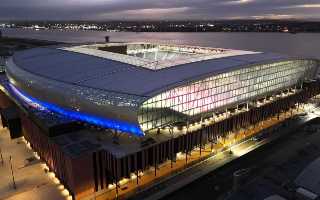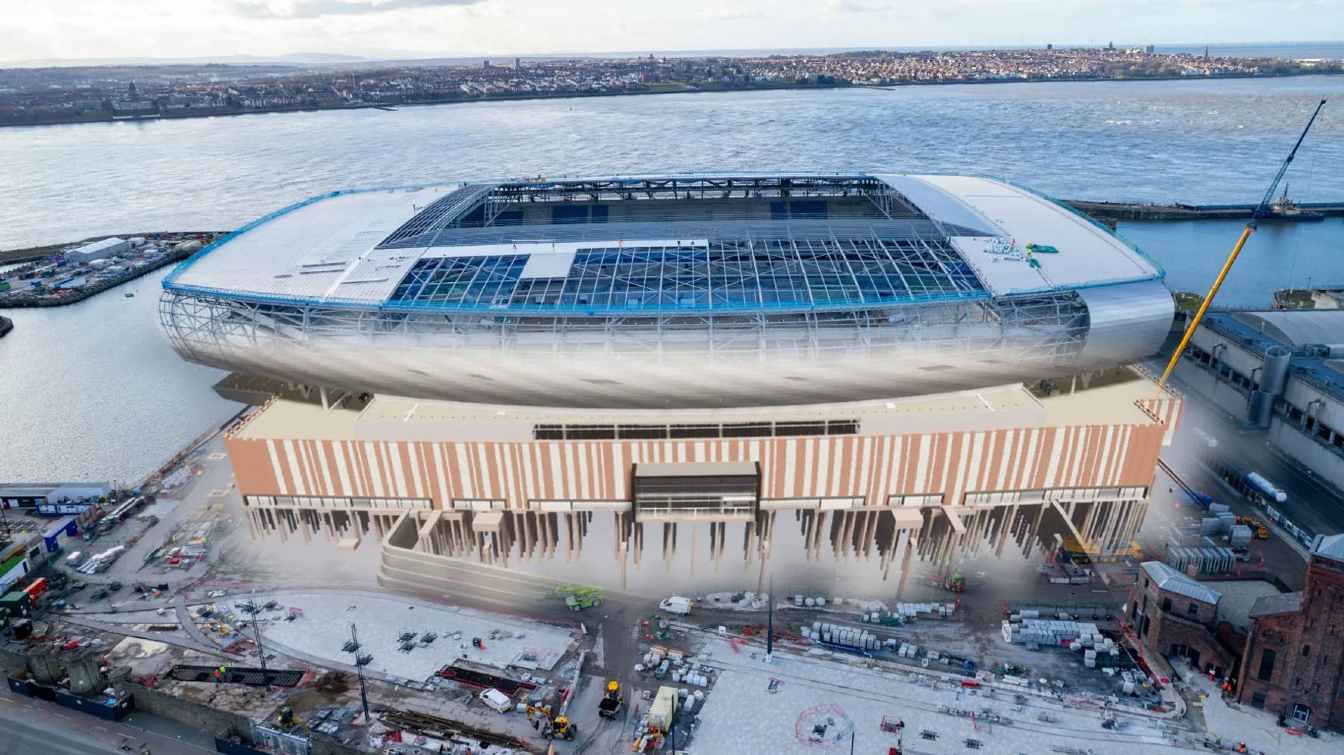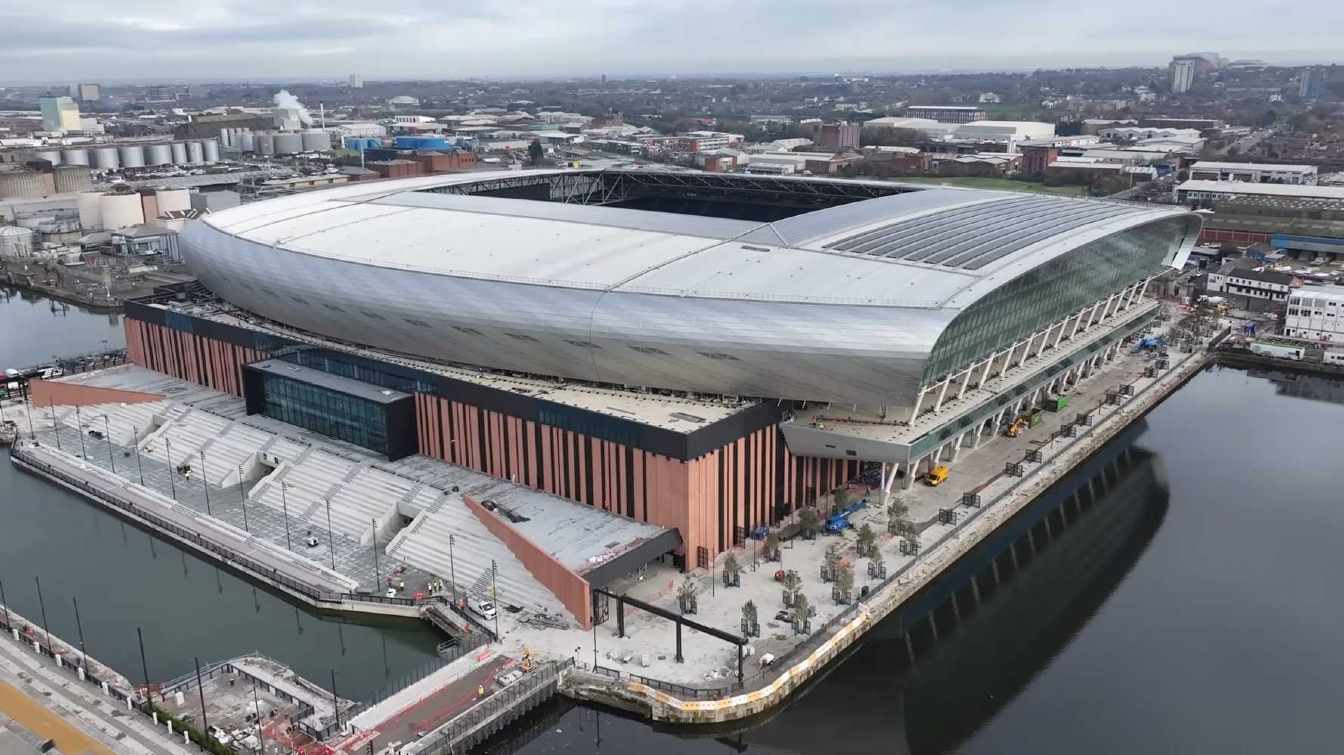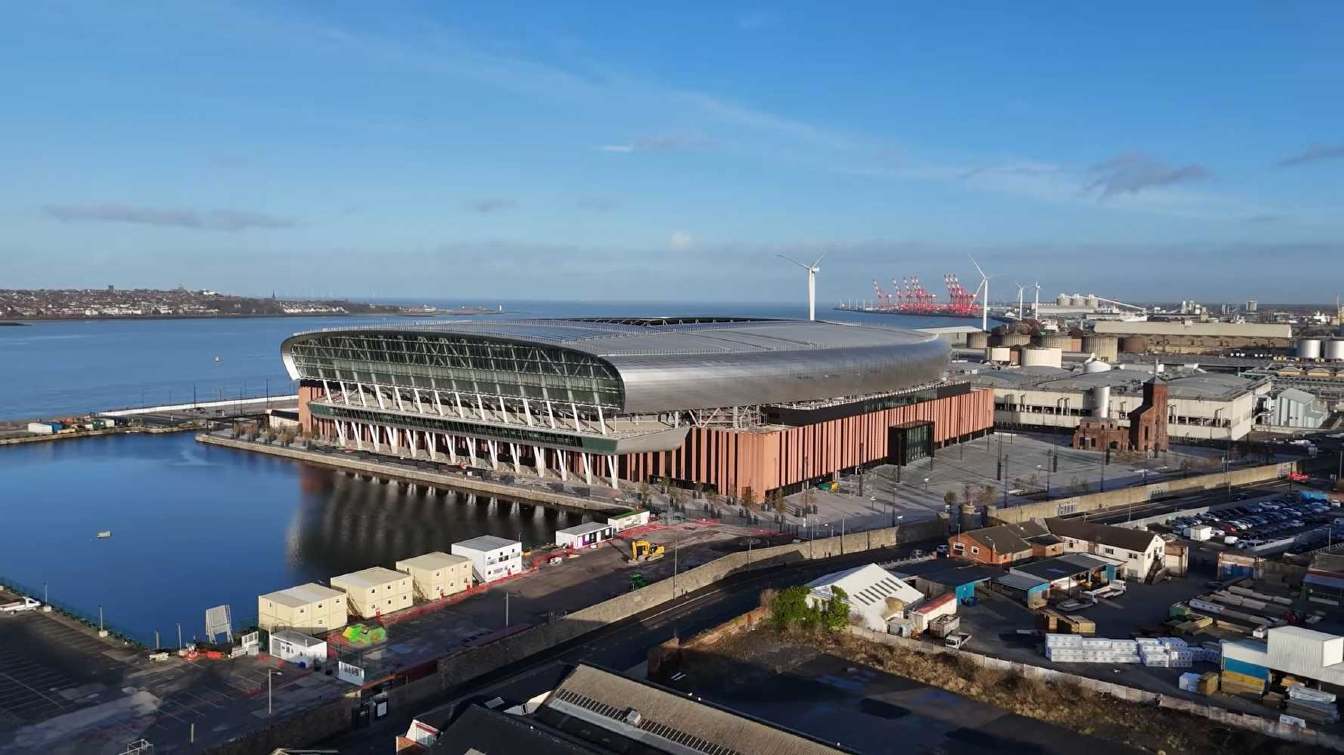England: New Everton Stadium – from dreams to opening day
source: StadiumDB.com; author: Paulina Skóra
 This Sunday, Everton will play its first league match at the new Hill Dickinson Stadium, marking a historic moment for the club and its supporters after more than two decades of efforts to secure a modern venue.
This Sunday, Everton will play its first league match at the new Hill Dickinson Stadium, marking a historic moment for the club and its supporters after more than two decades of efforts to secure a modern venue.
Advertisement
Project selection and location
Plans to move from Goodison Park began in the early 2000s, with Kings Dock initially considered. That project ultimately failed, and the club spent years searching for alternatives. The breakthrough came in 2017, when Bramley-Moore Dock on Liverpool’s northern waterfront was chosen as the preferred site.
The stadium was designed almost on the water after the old dock was filled in. Initially, a multi-level parking lot was planned nearby, but it was scrapped to avoid cutting the stadium off from the river. Dana Meis’ design divides the stadium into two main sections: the lower part references the port’s brick architecture (inspired by Stanley Dock), while the upper part is modern, transparent, illuminated, and showcases the rhythmic steel framework.
The stands are equally impressive: three tiers on the west side with business facilities, the iconic 13,000-seat blue wall
on the south stand, and the possibility to expand capacity from 52,000 to 62,000 if standing-area regulations in England change.
 © Everton FC | Hill Dickinson Stadium project
© Everton FC | Hill Dickinson Stadium project
Construction and challenges
Construction began in July 2021, with Laing O’Rourke as the main contractor. The first phase involved demolishing non-essential buildings, securing heritage elements, and filling in the dock basin. By early 2022, foundations were poured and the concrete corners of the stadium were erected.
The structure was built using modern Design for Manufacture and Assembly (DfMA) techniques. Steel and precast concrete components were produced off-site in controlled factory conditions and then assembled on location with precise 3D modeling.
The construction process was not without tragedy. In August 2023, longtime Everton fan and subcontractor Michael Jones died in an accident on site. A permanent memorial was unveiled in his honor in August 2024.
By February 2024, the stadium was considered complete after the final seating panel was installed. In March, financial problems arose with one subcontractor, Alucraft Systems, the supplier of façade panels, leaving £7.7 million in debt. Despite these difficulties, the stadium was officially handed over to the club in December 2024.
 © Mister Drone UK | Hill Dickinson Stadium in November 2024
© Mister Drone UK | Hill Dickinson Stadium in November 2024
Heritage and UNESCO status
Bramley-Moore Dock lies within the former Liverpool Maritime Mercantile City, previously listed as a UNESCO World Heritage Site. Despite Everton’s promises to preserve and restore historical elements, UNESCO ruled in 2021 that the stadium would have an unacceptable impact
on the site’s integrity and authenticity. Consequently, Liverpool lost its World Heritage status in July 2021, largely due to the Bramley-Moore Dock development.
Financing the stadium
The total construction cost is estimated at around £864 million. Initially, part of the funding was to come from a £280 million loan from Liverpool City Council, providing the city with an annual return of around £7 million over 25 years. The club also aimed to raise funds through stadium naming rights; in 2020, USM paid £30 million.
After Everton was taken over by The Friedkin Group, a long-term £350 million financial agreement was announced in 2025 with institutional investors including JP Morgan. Everton CEO Angus Kinnear emphasized that the new stadium will help the club succeed on the pitch, as revenue generated will be directly reinvested by the Friedkin Group.
Title sponsor
After months of searching, the club chose Hill Dickinson LLP, a local law firm founded in 1810 with offices in Liverpool, Monaco, Greece, Singapore, and Hong Kong, as the stadium’s naming sponsor. For Everton’s chairman, this was a strategic decision, while Hill Dickinson’s CEO described it as a once-in-a-generation opportunity.
Financial details were not disclosed, but reports suggested a deal for at least 10 years with an annual fee of around £9 million. Not all fans accepted the new name; some expressed disappointment, emphasizing attachment to the original Bramley-Moore Dock name, while others appreciated the local connection compared to large foreign corporations.
Test events
Everton staged a series of trial events to obtain safety certifications and league match licenses. The first took place on February 17, 2025, with 10,000 fans attending a match between Everton U18 and Wigan U18. The historic first scorer at the new stadium was Harrison Rimmer (Wigan), while Everton’s first goal was scored by 16-year-old Ray Robert from a penalty. The game ended 2-1 to the hosts.
The second test occurred on March 23 during a shortened 65-minute Everton U21 match against Bolton Reserves (0-1). A mandatory evacuation drill was also conducted, though feedback highlighted issues with public transport and traffic organization around the stadium.
Another test was a closed friendly against Port Vale, with the final trial being a friendly against AS Roma on August 9, 2025 — a week before the start of the new Premier League season. The attendance was 50,837, and Everton lost 0-1.
The city prepares for the big match
The first league game at Hill Dickinson Stadium will take place on August 24, 2025, at 14:00 local time against Brighton — Everton’s first league home match outside Goodison Park in 133 years.
Liverpool authorities are coordinating to minimize disruption. A transport working group prepared detailed plans for match day, offering fans various travel options. In addition to standard bus routes, four special lines will operate from Liverpool city center, Bootle, and Kirkby, with parking at each collection point. Merseyrail will run trains every 15 minutes on the Southport, Ormskirk, Hunts Cross, and Headbolt Lane lines before and after the match. Special ferry crossings will operate between Gerry Marsden Ferry Terminal at Pier Head and Seacombe for those traveling via the Mersey.
Advertisement

 StadiumDB
StadiumDB
